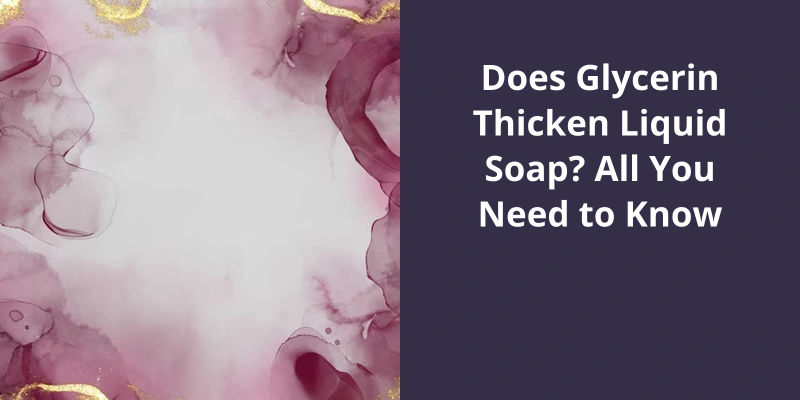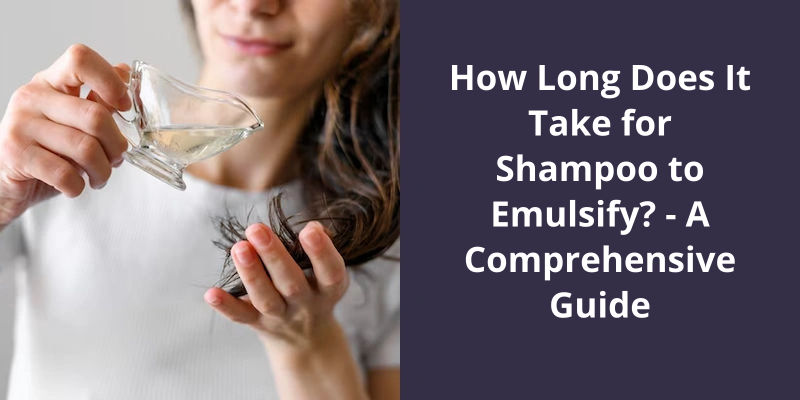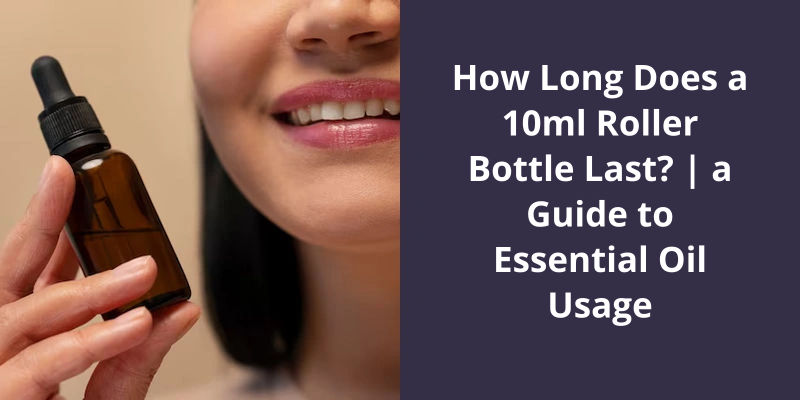Glycerin, primarily, does not act as a thickening agent in liquid soap. Instead, it acts as a humectant, which means that it helps to retain or preserve moisture in the soap. This property makes your skin feel smoother and softer after use. However, when used in high amounts, glycerin can change the viscosity of liquid soap, but it cannot effectively thicken it. If you want to thicken liquid soap, salts like table salt or a special salt like potassium chloride, or other ingredients like xanthan gum and corn starch, are commonly used. But it’s recommended to always follow the proportions and instructions provided in soap-making recipes to avoid ending up with overly thick or watery soap.

Can I Add Glycerin to My Liquid Soap?
Glycerin is a popular ingredient in many skincare products, thanks to it’s numerous benefits. It’s known for it’s moisturizing and hydrating properties, which help to keep the skin soft, supple, and youthful-looking. One of the main benefits of glycerin in liquid soap is that it acts as a humectant and attracts moisture from the surrounding air, keeping the skin hydrated and moisturized.
Many people wonder if they can add glycerin to their liquid soap and the answer is yes, you can. It’s also known to help prolong the shelf life of the product.
However, it’s important to note that glycerin and KOH don’t mix well at room temperature, so the mixture must be heated on the stovetop to achieve the desired consistency.
When it comes to adding glycerin to your liquid soap, youll need to measure the amount of glycerin you want to use carefully. Adding too much glycerin can result in a sticky and greasy product that won’t lather well, while adding too little may not have any effect on the overall texture. So, it’s important to get the ratios right to ensure your soap turns out as desired.
It also has numerous benefits for the skin and can help to keep skin hydrated and moisturized. However, it’s important to be aware of the downsides and take the necessary steps to ensure that the final product turns out as desired.
Different Ways to Add Glycerin to Liquid Soap
There are various methods to incorporate glycerin into your liquid soap. You could add it directly to the soap base during the formulation process or mix it with the finished soap. Another way is to dilute glycerin in water and use it as a spray to mist your soap after making. You can also opt to create a glycerin soap base and blend it with the liquid soap afterwards for added moisturization.
When it comes to soap, the removal of glycerin is a common practice among commercial manufacturers. Although it offers benefits such as increased shelf life, it also takes away the natural moisture that makes cold-processed, natural soaps so nourishing for the skin. With glycerin-free options becoming more readily available, consumers are beginning to recognize the value in using soap that retains this essential ingredient.
Why Remove Glycerin From Soap?
Glycerin is a natural part of the soap-making process that’s produced during saponification. It’s a humectant, which means it attracts moisture and helps to keep our skin hydrated. However, commercial soap manufacturers often choose to remove glycerin from their products during production. This is because glycerin can cause the soap to spoil more quickly, which reduces it’s shelf life. Removing glycerin also allows manufacturers to sell the glycerin separately, which can be used in other products like cosmetics and pharmaceuticals.
These synthetic ingredients are often introduced to make the soap more aesthetically pleasing and have a longer shelf life, but they can cause allergic reactions and other skin problems for many people.
In contrast, natural, cold-processed soaps that retain their glycerin are gentle on the skin and help to maintain it’s natural moisture levels. They often contain natural oils and butters that soften and hydrate the skin, while essential oils provide fragrance and healing properties. They’re also free from synthetic ingredients that can cause irritation and other skin problems.
While commercial soaps may have a longer shelf life, they often come at the expense of our skin. So next time youre shopping for soap, look for one that retains it’s glycerin and is made from natural ingredients. Your skin will thank you!
The Potential Harmful Effects of Synthetic Ingredients in Soap on Skin Health
- Synthetic ingredients in soap can cause skin irritation
- Some synthetic ingredients may cause allergic reactions
- Synthetic fragrances can disrupt the natural balance of the skin
- Harsh surfactants used in some synthetic soaps can strip the skin of it’s natural oils and cause dryness
- Synthetic colors used in soap can also cause skin irritation and allergic reactions
- Some synthetic preservatives can be harmful to skin and overall health
When it comes to creating the perfect consistency for liquid soap, thickeners play a significant role. However, not all thickeners are created equal, and it’s important to understand which type will work best for your specific needs. In this article, we’ll explore the different types of thickeners available for liquid soap and the benefits they offer.
What Is the Best Thickener for Liquid Soap?
Liquid soap is a popular household product that can be used for a variety of purposes ranging from washing hands to cleaning dishes. However, achieving the right consistency for liquid soap can be a challenge for many manufacturers. For this reason, there are various thickeners that can be added to liquid soap to help control it’s thickness. When considering the best thickener for liquid soap, several options can be used, including cellulose or gum-based thickeners.
These thickeners work by absorbing water and swelling, creating a gel-like consistency that thickens the liquid soap. They’re commonly used in personal care products such as shampoos, lotions, and creams because they provide good viscosity, stability, and clarity.
Another popular option for thickening liquid soap is guar gum, which is a soluble fiber derived from the guar plant. It can be added to liquid soap to improve it’s viscosity, stability, and texture. Guar gum is known for it’s gentle properties, making it a great choice for those with sensitive skin. It’s also easy to dissolve and provides excellent thickening properties.
Crothix is another common thickener used to thicken liquid soap. It’s a thickener that’s easy to use and can often be added directly to the soap without having to dissolve it first. This makes it a popular choice for small businesses or home soap makers who want a quick and easy way to thicken their liquid soap. Crothix is known for it’s ability to create a thick, luxurious lather that feels great on the skin.
Xanthan gum is a natural thickener made from fermented sugar that’s commonly used in food products. It’s easy to use and provides excellent viscosity and stability to liquid soap.
They each offer unique properties and benefits, making them versatile tools for creating high-quality liquid soap products. When choosing a thickener, it’s important to consider factors such as viscosity, stability, texture, and skin sensitivity to ensure that the product meets the desired specifications.
Now that we’ve an understanding of the properties of glycerin and how it’s used to make soap, we may wonder if glycerin soap melts under certain conditions. While the answer may seem straightforward, there are a few factors that can affect the melting point of glycerin soap. Let’s dive deeper into this topic and explore what causes glycerin soap to melt and how we can prevent it.
Does Glycerin Soap Melt?
The question whether glycerin soap melts is a common one among those who’ve used this type of soap or have heard about it. Unlike many other types of soap, glycerin soap isn’t a finished product, but rather a base or foundation for creating a variety of decorative and functional soap products. The glycerin soap base is typically sold in pre-cut cubes or in larger quantities that can be melted down for various uses.
When heated, the glycerin soap base can be easily molded into different shapes and designs. Some people use molds to create soap bars with intricate details, while others simply pour the melted soap into a large dish for easy use.
The melting point of glycerin soap varies depending on the amount of glycerin content in the base. This means that glycerin soap can easily melt when exposed to high temperatures or direct sunlight. For this reason, it’s recommended to store glycerin soap in a cool, dry place away from heat sources.
While glycerin soap may seem fragile due to it’s melting properties, it’s actually quite durable and long-lasting. Unlike traditional soap, which can often leave a drying residue on the skin, glycerin soap is gentle and moisturizing, making it an excellent choice for those with sensitive skin. Additionally, glycerin soap is biodegradable and environmentally friendly, making it a popular choice among eco-conscious consumers.
How Is Glycerin Soap Base Made?
Glycerin soap base is made through a multi-step process that involves heating and combining different oils and glycerin until a clear, viscous liquid is created. It’s important to use high-quality ingredients and follow precise measurements to create a soap base that’s effective yet gentle on skin.
Now that you know how much glycerin to add to your soap base, it’s important to also consider other factors that can affect the final product. This includes the type of soap base you’re using, any additional ingredients you want to include, and the intended use of the soap. With the right balance of glycerin and other ingredients, you can create a soap that’s both effective and enjoyable to use.
How Much Glycerin Do I Add to Soap Base?
When it comes to making soap, glycerin plays a crucial role in ensuring that the product is gentle on the skin. Glycerin is a natural humectant that attracts moisture to the skin and helps to keep it hydrated. It’s no wonder that many people want to know how much glycerin to add to their soap bases.
The recommended amount of glycerin for MP soap is one to one and a half teaspoons per pound of soap base. However, this is just a guideline, and the amount may vary depending on the specific recipe you’re using. It’s also important to note that different types of glycerin have varying degrees of purity, which can affect the overall quality of your soap.
How to Determine the Purity of Glycerin Before Adding It to Soap Base
- Check the ingredients list on the label to ensure that only pure glycerin is listed.
- Look for a clear, colorless liquid with no visible impurities or particles.
- Test the glycerin with a refractometer to determine if it’s the correct purity level.
- Perform a simple soap-making test with a small amount of the glycerin to see if it produces a clear and stable soap base.
- Consult with a reputable supplier or manufacturer to ensure the glycerin is of high quality and purity.
Conclusion
It’s humectant properties are also worth noting, as it can help enhance the skin's hydration levels. It’s versatility and benefits make it a must-try ingredient that's sure to elevate your soap-making experience.





